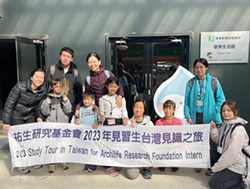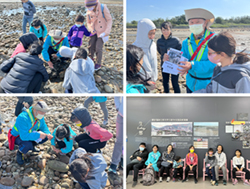
2023年11月18日由呂明澐小姐帶領10位祐生見習生及其家長們,至桃園新屋進行碳索生活暨客家海洋文化之旅。配合當天潮汐,行程首站即至新屋溪出海口週邊的海岸—觀新藻礁生態系野生動物保護區,眾人在乾潮之際,越過遍布螃蟹擬糞的沙灘,進入對外開放參觀的緩衝區,近距離觀察藻礁以及錯落其中的潮池。
For the study tour of November 18, 2023, Ms. Lu Ming-yun led 10 ARF interns and their parents on a trip to Xinwu, Taoyuan, to explore green living and Hakka ocean culture. Based on the tide times, the first stop of the itinerary was the Xinwu River Mouth: Guanxin Algal Reefs Ecosystem Wildlife Refuge. At low tide, everyone walked across the beach covered with feeding crabs and observed algal reefs and tidal pools in the buffer zone that is open to the public.

藻礁為生長於水域的底棲藻類死亡後鈣化並沉積而成,主成分為碳酸鈣,平均十年生成不足一公分,桃園主要的造礁藻類為殼狀珊瑚藻。導覽老師向眾人展示附著於岩石的紅褐色殼狀珊瑚藻,並拾取碎裂的藻礁與珊瑚礁,比較兩者紋理差異,指出藻類造礁速度遠遠不及珊瑚蟲,由此可見大片藻礁地景之稀有。藻礁具有多孔的特性,使其成為許多海洋生物的棲地,導覽老師首先透過手中的生物圖卡解說,讓眾人俯身仔細觀察腳下是否尋得圖卡中的寄居蟹、藤壺、石蚵與各式螺貝類。接著回到臨近的「藻礁生態環境教室」,該處前身為永興垃圾掩埋場,桃園市府將其活化轉型,館內介紹藻礁形成、分布與其所營造出的生態環境,替沿岸帶來豐富漁獲,進而形成以漁業為主的聚落,可見藻礁地景不只對維持生物多樣性有重大貢獻,與人類文化同樣息息相關。
Formed by the accumulation of calcified algae, an algal reef is primarily calcium carbonate and grows by less than one centimeter every 10 years. Algal reefs in Taoyuan are mainly formed by coralline algae. Showing everyone the red coralline algae clinging to rocks and drawing a comparison to coral reefs, the guide explained that algae construct reefs far slower than coral polyps, which is why vast expanses of algal reefs is rare. Due to its porosity, an algal reef provides a suitable habitat for marine organisms. The guide also urged everyone to bend down and look for hermit crabs, barnacles, oysters, and other types of conchs and shellfish seen in his picture cards. Back at the "Algal Reef Ecology Classroom" nearby, which was formerly Yongxing Landfill, everyone learned about the formation and distribution of algal reefs, and the ecological environment they create. This environment brings abundant fish catches to the coastal area, making it a hub for the fishing industry. Thus, it is evident that algal reefs are critical not only for maintaining biodiversity but also for our cultural development.

下午參訪位於新屋環境教育園區的碳索生活館,展館建築模仿台灣傳統合院格局,結合廢棄貨櫃打造,其中無論是大型螃蟹裝置藝術或小型海洋生物掛飾皆採用回收材料製作,導覽人員配合館內展示講述人類活動對自然造成的衝擊,並以館內各種回收材料為例,提倡垃圾減量,將減碳融入日常生活的食、衣、住、行、育、樂等方方面面。參觀結束後,眾人進行左手香手工肥皂DIY,見習生親手摘取園區內新鮮的左手香葉片,透過簡易工具榨取植物汁液後,加進融化的皂基中,藉由現地取材減少碳足跡,體會自然的餽贈。
Everyone visited the Green Life Museum in the afternoon, designed to resemble a traditional Taiwanese courtyard house although using abandoned cargo containers and recycled materials, including its large art installations and small decorations. The guide explained the impact of human activities on nature through exhibits, urged everyone to reduce waste and incorporate carbon reduction into every aspect of daily life. After the visit, everyone tried making DIY soap using freshly picked Indian borage grown on the premises. Interns extracted juice and added it to the soap base, reducing the carbon footprint while experiencing the gift of nature.
最後一站來到臨近永安漁港旁的海螺文化體驗園區,主建築外型為海螺剖面曲線意象,而位於中庭的地景藝術—風鈴,以吹海螺的聲音為發想,藉由海風吹動風鈴發出悅耳的鈴聲,令眾人不禁駐足聆聽。館內以海洋客家文化為主軸,讓眾人認識桃園沿海環境景觀,以及當地先民獨具特色的捕魚技巧與文化,如:吹響海螺,以號召眾人協助牽罟,再根據各自貢獻分配漁獲,此外也介紹為了保存漁獲而製作的「鹹醢」等醃漬食品。見習生們也透過虛擬實境互動小遊戲,了解先民如何堆砌石滬,利用潮汐漲退進行捕撈;石滬與現場展示的多數舊式漁具皆為先民就地取材製成,體現其靠海而居的不易以及堅韌的打拼精神。至此,本日活動已近尾聲,大家一起合照留念後搭車返程,並期待於下次見識之旅再相見。
The final destination of the tour was Yongan Conch Cultural Experience Park located next to Yongan Fishing Harbor. Shaped like a conch, it has a wind chime sculpture which makes beautiful melody in the wind. The park allows everyone to learn about the coastal environment, unique fishing skills, and the culture of early people in the area, e.g. blowing the conch to gather people to help pull the beach seine and distributing the catch according to their contribution. Through VR interactive games, interns also learned about how early people built stone weirs. The use of locally sourced materials by early people reflect difficulty of their livelihood and their relentless spirit. As the tour ended, everyone took a photo together and looked forward to the next tour.